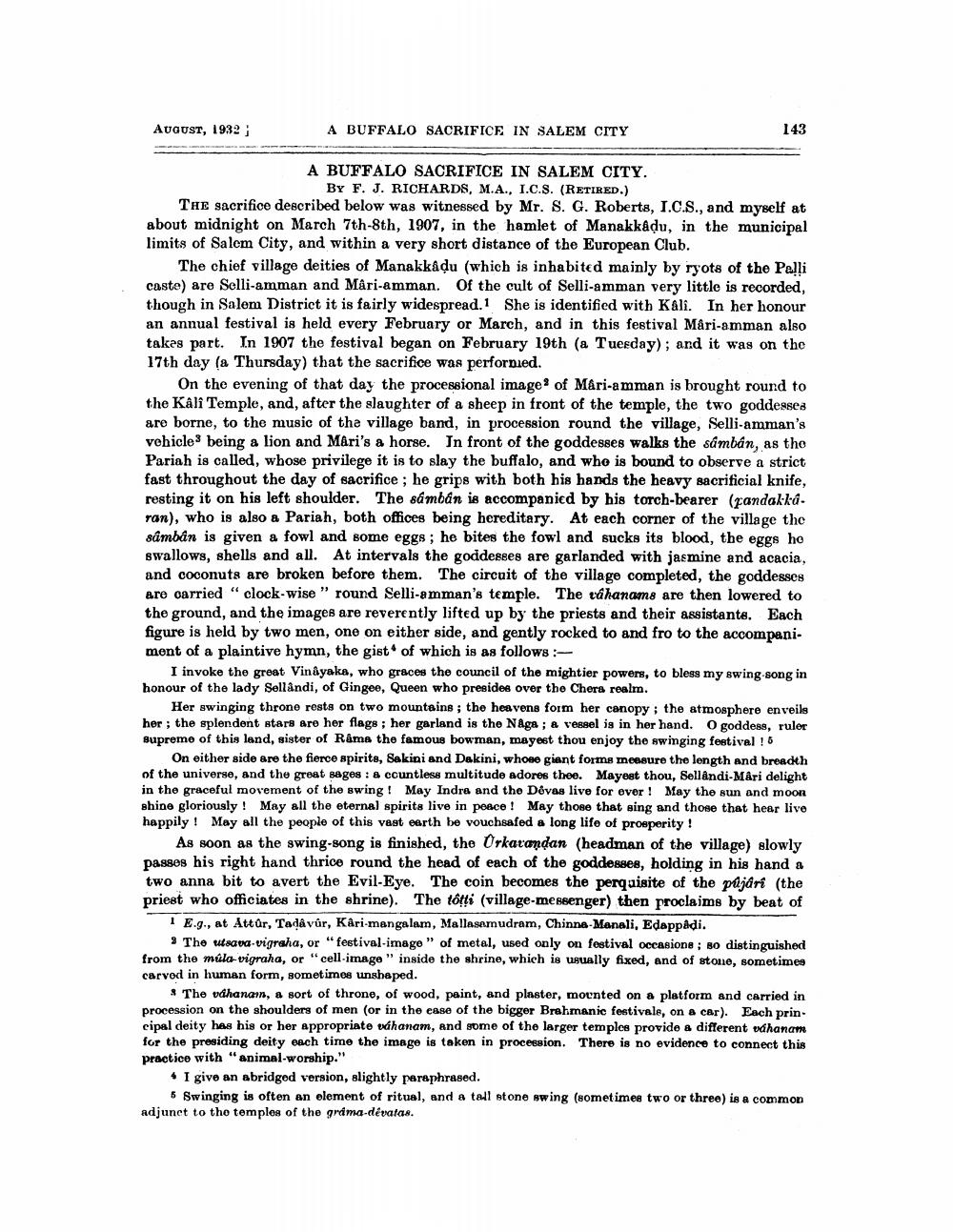________________
AUGUST, 1932;
A BUFFALO SACRIFICE IN SALEM CITY
143
A BUFFALO SACRIFICE IN SALEM CITY.
BY F. J. RICHARDS, M.A., I.C.S. (RETIRED.) THE sacrifice described below was witnessed by Mr. S. G. Roberts, I.C.S., and myself at about midnight on March 7th-8th, 1907, in the hamlet of Manakkadu, in the municipal limits of Salem City, and within a very short distance of the European Club.
The chief village deities of Manakkadu (which is inhabited mainly by ryots of the Palli caste) are Selli-amman and Mari-amman. Of the cult of Selli-amman very little is recorded, though in Salem District it is fairly widespread.1 She is identified with Kali. In her honour an annual festival is held every February or March, and in this festival Måri-amman also takes part. In 1907 the festival began on February 19th (a Tuesday); and it was on the 17th day (a Thursday) that the sacrifice was performied.
On the evening of that day the processional image of Måri-amman is brought round to the Kali Temple, and, after the slaughter of a sheep in front of the temple, the two goddesses are borne, to the music of the village band, in procession round the village, Selli-amman's vehicles being a lion and Mari's a horse. In front of the goddesses walks the sámban, as the Pariah is called, whose privilege it is to slay the buffalo, and who is bound to observe a strict fast throughout the day of sacrifice ; he grips with both his hands the heavy sacrificial knife, resting it on his left shoulder. The sámban is accompanied by his torch-bearer (randakka. ran), who is also a Pariah, both offices being hereditary. At each corner of the village the sâmbân is given a fowl and some eggs; he bites the fowl and sucks its blood, the eggs ho swallows, shells and all. At intervals the goddesses are garlanded with jasmine and acacia, and coconuts are broken before them. The circuit of the village completed, the goddesses are carried "clock-wise" round Selli-amman's temple. The ráhanams are then lowered to the ground, and the images are reverently lifted up by the priests and their assistante. Each figure is held by two men, one on either side, and gently rocked to and fro to the accompaniment of a plaintive hymn, the gist of which is as follows:
I invoke the great Vinayaka, who graces the council of the mightier powers, to bless my swing song in honour of the lady Sellândi, of Gingee, Queen who presides over the Chera realm.
Her swinging throne rests on two mountains; the heavens form her canopy; the atmosphere en veile her; the splendent stars are her flage; her garland is the Naga ; & vessel is in her hand. O goddess, ruler Supremo of this land, sister of Rama the famous bowman, mayest thou enjoy the swinging festival ! 6
On either side are the fierce spirits, Sakini and Dakini, whose giant forms measure the length and breadth of the universe, and the great Bages : & countless multitude adores thoe. Mayest thou, Sellândi-Mâri delight in the graceful movement of the swing! May Indra and the Déves live for ever! May the sun and moon shine gloriously! May all the eternal spirits live in peace ! May those that sing and those that hear live happily! May all the people of this vast earth be vouchsafed a long life of prosperity !
As soon as the swing-song is finished, the Orkarandan (headman of the village) slowly passes his right hand thrice round the head of each of the goddesses, holding in his hand a two anna bit to avert the Evil-Eye. The coin becomes the perquisite of the ptjärí (the priest who officiates in the shrine). The totti (village-messenger) then proclaims by beat of
1 E.g., at Attur, Tadâvûr, Kari mangalam, Mallasamudram, Chinna Manali, Edappadi.
9 The utsava vigraha, or "festival-image" of metal, used only on festival occasione ; 80 distinguished from the múla-vigraha, or "cell-image" inside the shrine, which is usually fixed, and of stone, sometimes carvod in human form, sometimes unshaped.
# The vdhanam, a sort of throne, of wood, paint, and plaster, mounted on a platform and carried in procession on the shoulders of men (or in the case of the bigger Brahmanic festivale, on a car). Each prin cipal deity has his or her appropriate váhanam, and some of the larger temples provide a different exchanam for the presiding deity each time the image is taken in procession. There is no evidence to connect this practice with "animal-worship."
• I give an abridged version, slightly paraphrased.
6 Swinging is often an element of ritual, and a tall stone swing (sometimes two or three) is a common adjunct to the temples of the grdma-devatas.




